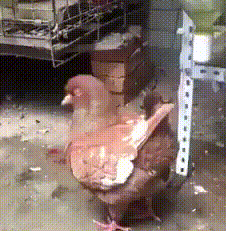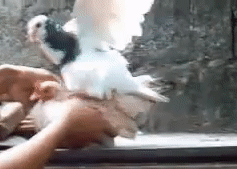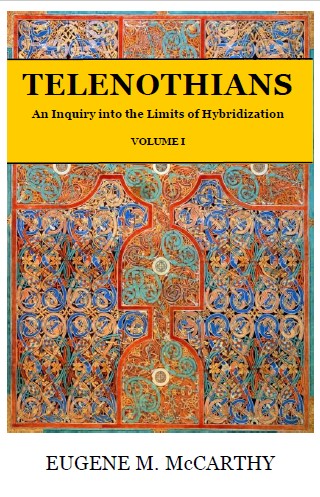Chicken-pigeon Hybrids
This page was a draft for a section of my now-finished book on distant hybrids, available here >>
Caution: Although the sheer anatomy of these birds (pigeon head + chicken body) strongly indicates they are pigeon-chicken hybrids, this cross, which would be interordinal (Galliformes × Columbiformes), has not been confirmed via controlled breeding experiments.
Videos exist on YouTube showing birds that appear to be chicken-pigeon composites (example). Thus, the bird at right is reported as having been produced in China in 2017. In general, these animals have the heads of pigeons, but the body of a chicken.
Certainly pigeon cocks will willingly mate with hens, as shown in the video at right. So there is no behavioral or physical barrier in this cross. But what about physiological barriers? If pigeon semen is delivered to a hen’s cloaca, can anything come of it?
Those who believe that such a hybrid would be impossibly distant assert that such birds are merely a chicken-like breed of pigeon and not hybrids at all. However, people often forget that many existing breeds of both birds and mammals are known to have been produced via hybrid crosses, the beefalo (from bison × cattle) and the red-factor canary (Serinus domesticus × Carduelis cucullata) being prominent examples.
So the mere fact that they have been described as breeds (e.g., Modena breed, or Banat Chicken Pigeon breed) does not preclude the possibility that these birds—supposed pure pigeons with chicken traits— actually have a forgotten hybrid origin. As Zirkle (1935), points out, when a breed is fertile, it’s easy to forget that it was derived from hybridization.
And there are in fact old accounts of breeders producing pigeon-chicken hybrids, which would explain how the various breeds that look like pigeon-chicken hybrids were first developed. Thus, in explaining how to produce various avian crosses, the Neapolitan scholar, polymath and playwright Giambattista della Porta (1658, p. 45), who spent the larger portion of his life on scientific endeavors, claimed to have produced pigeon-chicken hybrids and gives his readers instructions for doing the same:
Chromosome counts: A diploid somatic cell from a pigeon (Columba livia) has a total of 80 chromosomes (2n = 80), that of a chicken (Gallus gallus), 78 (2n=78).
So, at least according to Porta, the direction of this cross would be male pigeon × hen (as seen in the video above), although it is conceivable that it might also work the other way around. It should perhaps be pointed out that, if these breeds were in fact developed from such hybrids, then at least some of F1 hybrids initially produced from this interordinal cross must have been capable of producing offspring. And, like most hybrids that are able reproduce themselves and that eventually become breeds, their origins tend to be forgotten, because there is not the sterility, as in the common mule, that lingers on to point to their origins.
And what are the birds in the video below, if not chicken-pigeon hybrids?
A pigeon with large webbed feet >>
By the same author: Handbook of Avian Hybrids of the World, Oxford University Press (2006).
Most shared on Macroevolution.net:
Human Origins: Are we hybrids?
On the Origins of New Forms of Life
Mammalian Hybrids
Cat-rabbit Hybrids: Fact or fiction?
Famous Biologists
Dog-cow Hybrids
Georges Cuvier: A Biography
Prothero: A Rebuttal
Branches of Biology
Dog-fox Hybrids
Chicken-pigeon Hybrids - © Macroevolution.net

 A pigeon cock willingly mating with a chicken (
A pigeon cock willingly mating with a chicken (